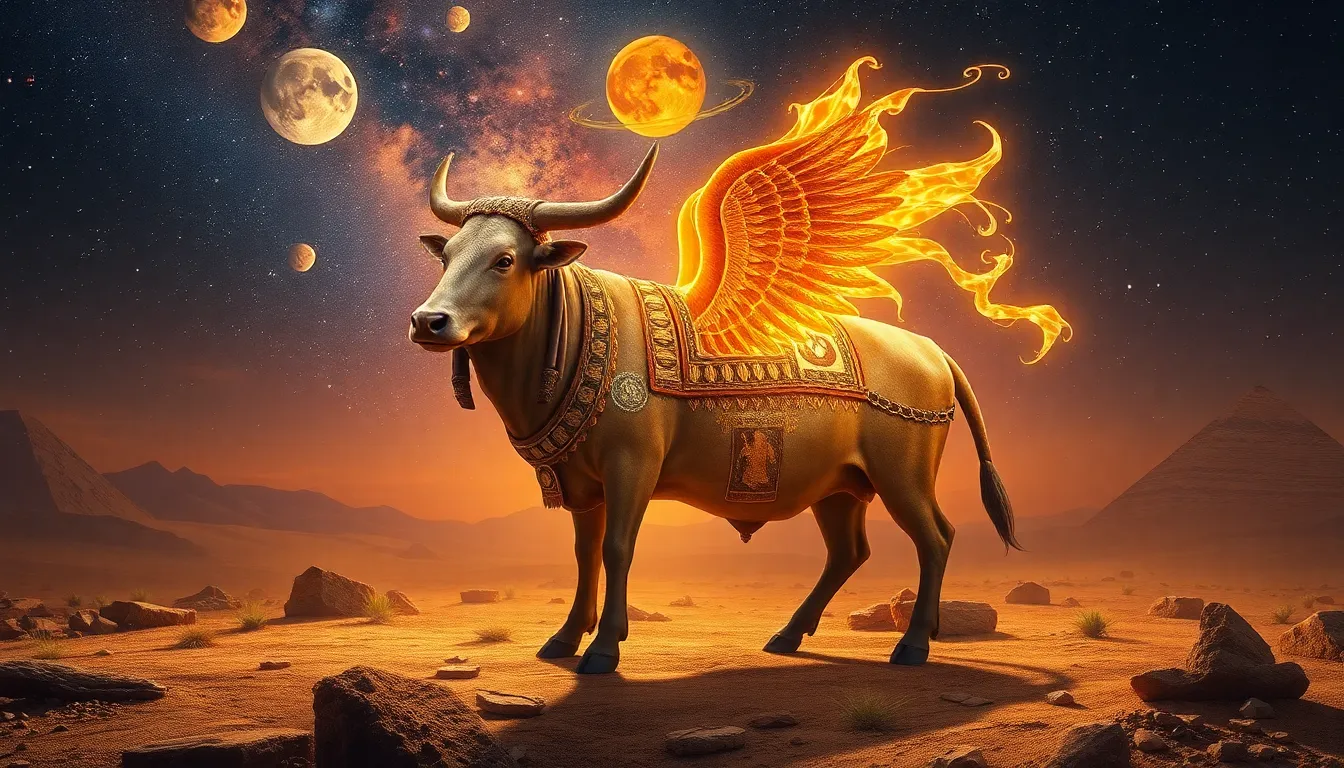The Myth of the Celestial Cow: Nut’s Role in Creation
I. Introduction
In ancient Egyptian mythology, Nut is a vital figure whose significance is deeply woven into the fabric of creation narratives. She is often depicted as the celestial cow, a symbol of the sky that arches over the earth, embodying the essence of nurturing and life-giving forces. The myth of the Celestial Cow not only highlights Nut’s importance but also serves as a fascinating exploration of the ancient Egyptians’ understanding of the cosmos and their spirituality. This article aims to delve into Nut’s role in creation and the broader implications of her myth in Egyptian culture.
II. Background on Egyptian Mythology
Egyptian mythology is rich with themes of creation, death, and the afterlife. Central to this belief system is the idea that the universe was brought into existence from a primordial chaos, often referred to as Nun. The ancient Egyptians believed in a pantheon of gods and goddesses, each playing a specific role in the maintenance of order, known as Ma’at, in the universe.
Creation myths in Egyptian tradition vary, but they often share common elements and deities, including:
- Atum – the creator god who emerged from Nun.
- Geb – the earth god, who is Nut’s counterpart.
- Shu – the god of air, who separates Nut and Geb.
These deities collectively contributed to the creation of the world, humanity, and the natural order.
III. The Celestial Cow: Symbolism and Interpretation
Nut is often depicted as a cow, with her body representing the sky and her stars symbolizing nourishment and life. As the Celestial Cow, Nut embodies several symbolic meanings:
- Fertility: The cow is a powerful symbol of fertility and motherhood in ancient Egypt, reflecting Nut’s role in nurturing the cosmos.
- Nourishment: Just as a cow provides milk, Nut is seen as a provider of sustenance for both gods and mortals.
- Protection: Her arching body serves as a protective canopy over the earth, safeguarding all that lies beneath her.
Thus, Nut’s representation as a celestial cow encapsulates her multifaceted role in Egyptian mythology, emphasizing her connection to fertility and nourishment.
IV. The Creation Myth Involving Nut
The creation story featuring Nut is both beautiful and complex. According to the myth, Nut was born from the primordial waters of Nun and was destined to give birth to the sun and the stars. The narrative unfolds as follows:
- Nut, in her celestial form, arches over her counterpart Geb, the earth.
- Shu, the god of air, separates Nut from Geb, allowing light and life to emerge between them.
- From Nut’s body, the sun god Ra is born at dawn, illuminating the world.
- Throughout the night, Nut swallows the sun, only to give birth to it again each morning.
This cyclical act of creation through Nut’s body reinforces her role as a life-giver and protector of the cosmos. Her arching form symbolizes the horizon, where the earth meets the sky, and serves as a reminder of the unity between the two realms.
V. The Relationship Between Nut and Other Deities
Nut’s relationships with other deities are critical to understanding her role in Egyptian mythology:
- Nut and Geb: As husband and wife, Nut and Geb represent the duality of sky and earth. Their union is essential for the continuation of life.
- Nut and Ra: Nut’s relationship with Ra is pivotal, as she gives birth to him each day, symbolizing the eternal cycle of life and death.
- Divine Family: Nut is part of a larger divine family, including Osiris, Isis, Seth, and Nephthys, all of whom play significant roles in various myths surrounding creation and the afterlife.
These connections highlight Nut’s integral position within the cosmic order and the interconnectedness of the deities in maintaining balance in the universe.
VI. Nut in Art and Literature
Nut’s image and influence extend beyond mythology into art and literature:
- Artistic Representations: In ancient Egyptian art, Nut is commonly depicted as a woman with a star-covered body, often arching over Geb. This visual representation emphasizes her role as the sky goddess.
- Textual References: Nut is mentioned in various religious texts, including the Pyramid Texts and Coffin Texts, where her role in creation and protection is elaborated upon.
- Cultural Influence: Nut’s imagery has influenced later cultures and religions, with her symbols appearing in various forms in art and literature throughout history.
Her portrayal in art and literature not only underscores her importance in the ancient world but also illustrates how her myth has persisted through time.
VII. Contemporary Interpretations and Relevance
Today, Nut’s myth and symbolism continue to resonate in various ways:
- Modern Perspectives: Scholars and enthusiasts of mythology draw parallels between Nut’s nurturing qualities and contemporary themes of motherhood and protection.
- Spiritual Influence: Nut’s image has been embraced in modern spiritual practices, often symbolizing the nurturing aspects of the universe.
- Popular Media: Elements of Nut’s myth can be found in literature, films, and art, reflecting her enduring legacy in popular culture.
Nut’s story serves as a reminder of the ancient Egyptians’ profound connection to the cosmos and their reverence for the forces of nature.
VIII. Conclusion
In conclusion, Nut’s significance in the creation myths of ancient Egypt is both profound and multifaceted. Her role as the Celestial Cow highlights themes of fertility, nourishment, and cosmic order. Understanding these mythological narratives not only enriches our knowledge of ancient cultures but also reflects the timeless human concerns of life, death, and the interconnectedness of all beings. The legacy of the Celestial Cow endures, reminding us of the nurturing forces that shape our world today.




